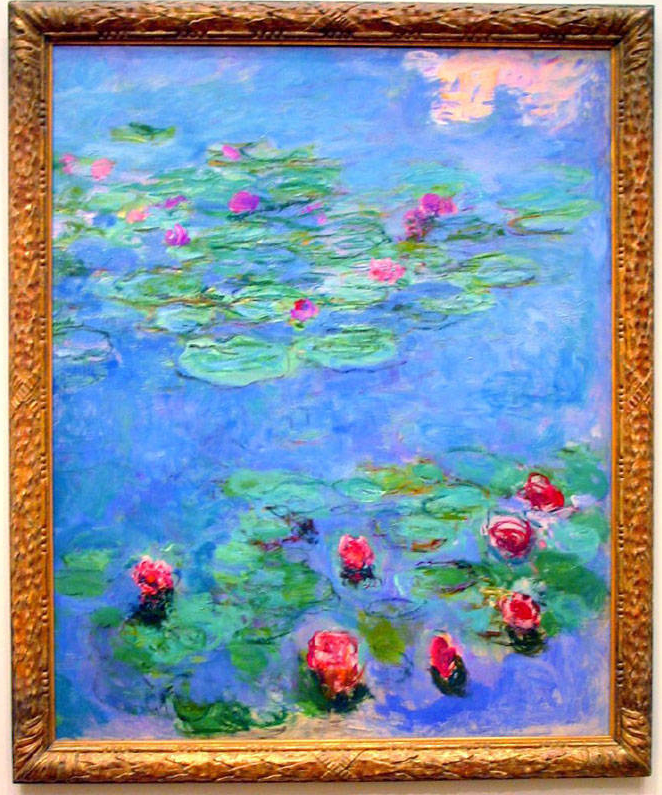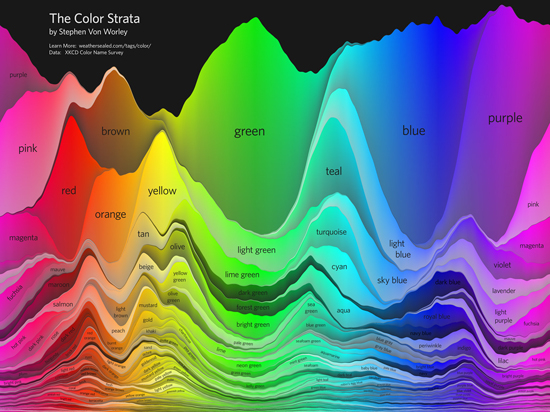
Claude Monet’s “Water Lilies” can be acclaimed as one of outstanding works by this ingenuous painter. The painting uses a wide range of bright, saturated and complementary colours. This use of colour harmony can be described as one of the most notorious and indicative works by impressionists.
The Range of Colour
Speaking about the range of colour which can be seen in this painting, it should be said that it is rather varied and features basic colours such as blue as the main colour for the picture used as background, red, and yellow in the upper right along with numerous colour tinctures including white, green, brown and black.



Category and Attributes of Colour
There exist four categories of colour including conventional colour, substance colour, spectral profile colour and profile colour (Green-Armytage, 2006). Analysing this painting, it should be stated that Monet resorts to the use of conventional colours. For example, blue is conventional for water, red for flowers and so on. Speaking about substance colour in this painting, the three main notions should be addressed including the painting’s hue, saturation and tone. In this painting Monet resorts to the use of natural hues, strong saturation and bright tones.
Type of Colour Contrast
Chevreul (1839) was adherent to the idea that colour harmony has a strong tendency to be connected to colour contrast and colour compatibility. His theories also affected Monet’s way of thinking. Thus, Monet applies highly compliment colour in this painting. According to Chevreul’s theory, the painting may be characterised as using complement colours; however the theories by the other specialists suggest different points of view on this matter. Still, the majority of specialists state that such colours as blue and yellow which can be seen in this painting are to be considered as contrasting (Itten 1961, 1963).
Gestalt Theories of Perception
According to Gestalt theory, the main perception factors which are the most important for visual perception are colour, line, contour, contrast, tone and texture. Each individual’s visual perception is affected by apprehension of individual stimuli which are also known as perceptual factors along with individual’s imaginary. People have a tendency to think over any particular object until they will be able to identify it to something familiar within this particular object. Judging on this factor, the painting can be evaluated as having easily noticed objects as lilies and water along with the rest ones such as the sky reflecting in the water.
Perceptual Effects
Perceptual effects are rather many. They often occur in the most diversified settings and bearings. People have a tendency to be affected mainly by colour and colour contrast. Depending on the context and the objectives of their work painters resort to the use of the most varied perceptual effects. In this painting Monet seems to have an objective to impress the audience by the beauty of the pond’s water in its combination with lilies. Thus, he applies strong colour contrast. In addition, sample colours may be affected by the other colours creating the colour system of the painting. The whole painting “Water Lilies” can be acclaimed as featuring highly complement and saturated colours which strengthens the impression it produces. The entire painting’s colour system appears very bright and thus, producing pleasant impression. Monet uses light colour for this picture which makes it appearing nearer to the viewer. In addition, the colours in this painting appear perceptually vibrate adding to its special liveliness and charm. Such vibrant colours as red, blue, yellow, violate, and pink were often used by impressionist to affect their audience. This painting can be described as one of the most vivid examples of such tendency by impressionists to whom Monet can be related as one of the most outstanding. Separated colours of every image when they are evaluated together by the viewer seem to produce new ones from a distance. This can be observed in the colours of the lilies which seem to appear rosier from distance when affected by blue.
The area of strong contrast which is created by hue or saturation attracts visual attention (Boynton, 1979). This painting can be described as a good example of attracting one’s attention on the above mentioned reason. In addition, strong contrast is accepted quickly and easily; this is what happens in the case of this painting. Whereas poor contrast may present a difficulty in experiencing the image by people especially elderly ones and those with poor eye-sight. This picture, on the contrary, presents a good example of strong contrast adding to its easy perception by different viewers.
In conclusion, Claude Monet’s “Water Lilies” can be described as featuring complementary colours, high level of saturation and vibrancy which makes it very appealing to the audience. In this painting Monet resorts to the use of natural hues and bright tones which adds to the picture’s colour harmony and the positive impression it produces. Such vibrant colours as red, blue, yellow, violate, and pink were often used by impressionist to affect their audience. This painting can be described as one of the most vivid examples of such tendency by impressionists.
References
- Boynton, R. M. (1979). Human color vision. New York: Holt, Reinhart & Winston.
- Chevreul, M. E. (1855). The principles of harmony and the contrast of colours: And their applications to the arts (Facsimile edition; Trans. C Martel). Whitefish, MT: Kessinger Publishing.
- Green-Armytage, P. (2006). The value of knowledge for colour design. Color Research and Application, 31 (4), 253-269.
- Itten, J. (1961). The art of color (Revised edition, 1973). New York: John Wiley.
- Itten, J. (1963). Design and form: The basic course at the Bauhaus and later (Revised edition, 1975). New York: John Wiley & Sons.